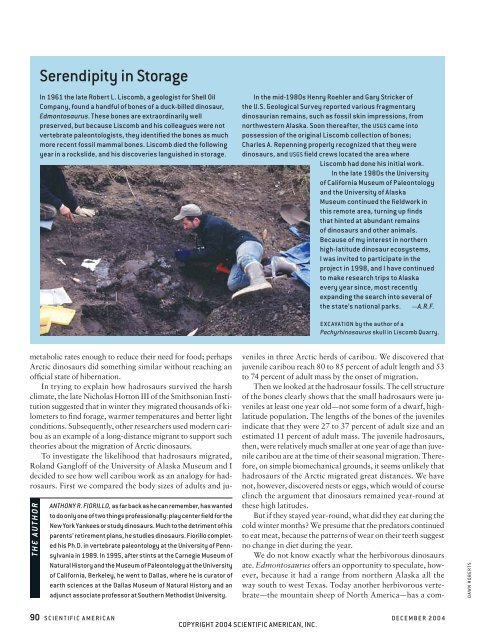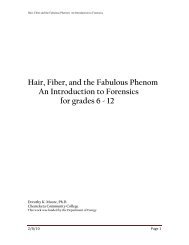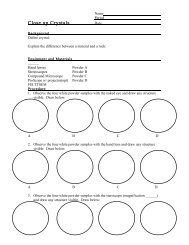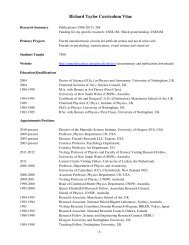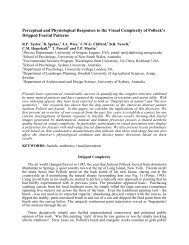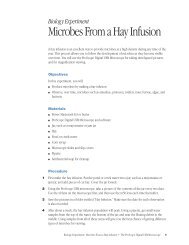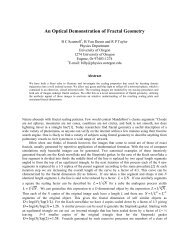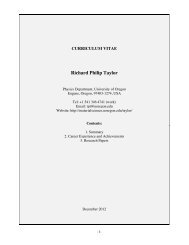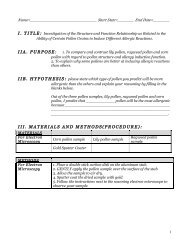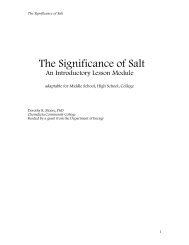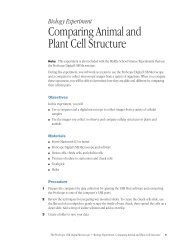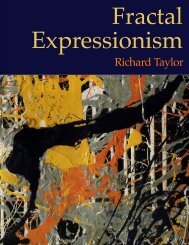December 2004 - Materials Science Institute - University of Oregon
December 2004 - Materials Science Institute - University of Oregon
December 2004 - Materials Science Institute - University of Oregon
Create successful ePaper yourself
Turn your PDF publications into a flip-book with our unique Google optimized e-Paper software.
Serendipity in Storage<br />
Company, found a handful <strong>of</strong> bones <strong>of</strong> a duck-billed dinosaur,<br />
Edmontosaurus. These bones are extraordinarily well<br />
preserved, but because Liscomb and his colleagues were not<br />
vertebrate paleontologists, they identifi ed the bones as much<br />
more recent fossil mammal bones. Liscomb died the following<br />
year in a rockslide, and his discoveries languished in storage.<br />
metabolic rates enough to reduce their need for food; perhaps<br />
Arctic dinosaurs did something similar without reaching an<br />
<strong>of</strong>fi cial state <strong>of</strong> hibernation.<br />
In trying to explain how hadrosaurs survived the harsh<br />
climate, the late Nicholas Hotton III <strong>of</strong> the Smithsonian Institution<br />
suggested that in winter they migrated thousands <strong>of</strong> kilometers<br />
to fi nd forage, warmer temperatures and better light<br />
conditions. Subsequently, other researchers used modern caribou<br />
as an example <strong>of</strong> a long-distance migrant to support such<br />
theories about the migration <strong>of</strong> Arctic dinosaurs.<br />
To investigate the likelihood that hadrosaurs migrated,<br />
Roland Gangl<strong>of</strong>f <strong>of</strong> the <strong>University</strong> <strong>of</strong> Alaska Museum and I<br />
decided to see how well caribou work as an analogy for hadrosaurs.<br />
First we compared the body sizes <strong>of</strong> adults and ju-<br />
ANTHONY R. FIORILLO, as far back as he can remember, has wanted<br />
to do only one <strong>of</strong> two things pr<strong>of</strong>essionally: play center fi eld for the<br />
New York Yankees or study dinosaurs. Much to the detriment <strong>of</strong> his<br />
parents’ retirement plans, he studies dinosaurs. Fiorillo completed<br />
his Ph.D. in vertebrate paleontology at the <strong>University</strong> <strong>of</strong> Pennsylvania<br />
in 1989. In 1995, after stints at the Carnegie Museum <strong>of</strong><br />
Natural History and the Museum <strong>of</strong> Paleontology at the <strong>University</strong><br />
<strong>of</strong> California, Berkeley, he went to Dallas, where he is curator <strong>of</strong><br />
earth sciences at the Dallas Museum <strong>of</strong> Natural History and an<br />
adjunct associate pr<strong>of</strong>essor at Southern Methodist <strong>University</strong>.<br />
THE AUTHOR In 1961 the late Robert L. Liscomb, a geologist for Shell Oil<br />
In the mid-1980s Henry Roehler and Gary Stricker <strong>of</strong><br />
the U.S. Geological Survey reported various fragmentary<br />
dinosaurian remains, such as fossil skin impressions, from<br />
northwestern Alaska. Soon thereafter, the USGS came into<br />
possession <strong>of</strong> the original Liscomb collection <strong>of</strong> bones;<br />
Charles A. Repenning properly recognized that they were<br />
dinosaurs, and USGS fi eld crews located the area where<br />
Liscomb had done his initial work.<br />
In the late 1980s the <strong>University</strong><br />
<strong>of</strong> California Museum <strong>of</strong> Paleontology<br />
and the <strong>University</strong> <strong>of</strong> Alaska<br />
Museum continued the fi eldwork in<br />
this remote area, turning up fi nds<br />
that hinted at abundant remains<br />
<strong>of</strong> dinosaurs and other animals.<br />
Because <strong>of</strong> my interest in northern<br />
high-latitude dinosaur ecosystems,<br />
I was invited to participate in the<br />
project in 1998, and I have continued<br />
to make research trips to Alaska<br />
every year since, most recently<br />
expanding the search into several <strong>of</strong><br />
the state’s national parks. —A.R.F.<br />
EXCAVATION by the author <strong>of</strong> a<br />
Pachyrhinosaurus skull in Liscomb Quarry.<br />
veniles in three Arctic herds <strong>of</strong> caribou. We discovered that<br />
juvenile caribou reach 80 to 85 percent <strong>of</strong> adult length and 53<br />
to 74 percent <strong>of</strong> adult mass by the onset <strong>of</strong> migration.<br />
Then we looked at the hadrosaur fossils. The cell structure<br />
<strong>of</strong> the bones clearly shows that the small hadrosaurs were juveniles<br />
at least one year old—not some form <strong>of</strong> a dwarf, highlatitude<br />
population. The lengths <strong>of</strong> the bones <strong>of</strong> the juveniles<br />
indicate that they were 27 to 37 percent <strong>of</strong> adult size and an<br />
estimated 11 percent <strong>of</strong> adult mass. The juvenile hadrosaurs,<br />
then, were relatively much smaller at one year <strong>of</strong> age than juvenile<br />
caribou are at the time <strong>of</strong> their seasonal migration. Therefore,<br />
on simple biomechanical grounds, it seems unlikely that<br />
hadrosaurs <strong>of</strong> the Arctic migrated great distances. We have<br />
not, however, discovered nests or eggs, which would <strong>of</strong> course<br />
clinch the argument that dinosaurs remained year-round at<br />
these high latitudes.<br />
But if they stayed year-round, what did they eat during the<br />
cold winter months? We presume that the predators continued<br />
to eat meat, because the patterns <strong>of</strong> wear on their teeth suggest<br />
no change in diet during the year.<br />
We do not know exactly what the herbivorous dinosaurs<br />
ate. Edmontosaurus <strong>of</strong>fers an opportunity to speculate, however,<br />
because it had a range from northern Alaska all the<br />
way south to west Texas. Today another herbivorous vertebrate—the<br />
mountain sheep <strong>of</strong> North America—has a com-<br />
90 SCIENTIFIC AMERICAN DECEMBER <strong>2004</strong><br />
COPYRIGHT <strong>2004</strong> SCIENTIFIC AMERICAN, INC.<br />
DAWN ROBERTS


